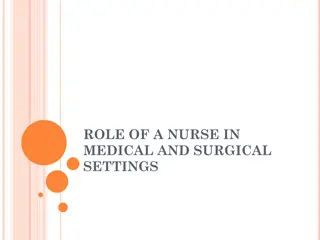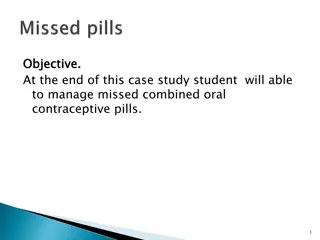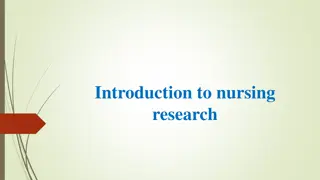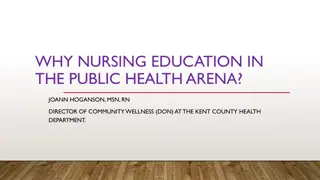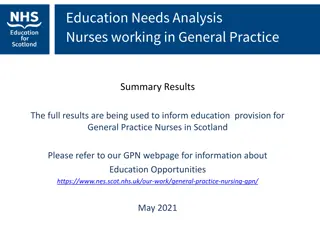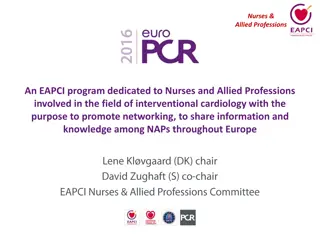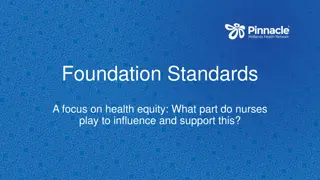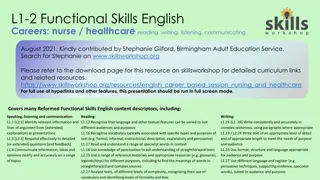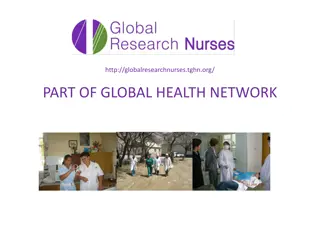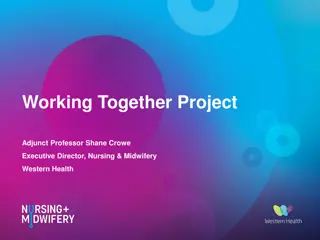Nurses Research Findings: Missed Opportunities
Nurses play a crucial role in advancing healthcare through research. By publishing their findings, they can share valuable insights, improve patient outcomes, and elevate the credibility of the nursing profession. However, various barriers hinder nurses from publishing their research, such as exhaustion, lack of writing skills, and fear of rejection. Overcoming these obstacles is essential for enhancing chronic disease management and diabetes programs in primary care settings.
Uploaded on Feb 17, 2025 | 0 Views
Download Presentation

Please find below an Image/Link to download the presentation.
The content on the website is provided AS IS for your information and personal use only. It may not be sold, licensed, or shared on other websites without obtaining consent from the author.If you encounter any issues during the download, it is possible that the publisher has removed the file from their server.
You are allowed to download the files provided on this website for personal or commercial use, subject to the condition that they are used lawfully. All files are the property of their respective owners.
The content on the website is provided AS IS for your information and personal use only. It may not be sold, licensed, or shared on other websites without obtaining consent from the author.
E N D
Presentation Transcript
Nurses Research Findings: Missed Opportunities Jane Campion RGN MHSc Primary Care HealthCare Minds Ltd 22nd October 2012
Why is it important for Nurses to publish their Research? Share knowledge Share skills Share experiences Change clinical practice Improve user outcomes Increase visibility of Nursing profession Increase credibility of Nursing profession
Colleagues Personal Experiences I never want to see it again To be honest I m afraid someone will turn around and say that s all rubbish I meant to, but never got around to it I didn t find my supervisor very supportive when I was doing the research, and now I really don t know how to go about it (publishing) .I don t want to ask them to co-author
Barriers to Publishing Exhaustion Daunting task Lack of writing skills Self confidence Poor incentives Unfavourable feedback Lack of finance Ref: Heyman B, Cronin P (2005) , Happell, B. (2005).
Barriers to Publishing Lack of Understanding of How to Write for Publication Writer s Block Lack of Time Fear of Rejection Ref: Oermann MH, C. Hays JC. (2011). Carlson, Masters, & Pfadt, 2008, Shah, Shah, & Pietrobon, 2009, McGaghie & Webster, 2009
Chronic Disease Management in Primary Care Practice Nurses (PN) provide much of the care for patients with chronic diseases Key findings of one unpublished Irish study showed: PN have vital role to play in chronic disease management in General Practice and Practices with a PN are more likely to have improvements in chronic disease management and practice targets at an advanced or optimum level. Ref: Taylor SJC 2005, Robinson C. 2007
Diabetes Programmes Self management with support enhances outcomes in Diabetes programmes Self-management education teaches problem-solving skills and results in enhanced self-efficacy as well as facilitating optimum QOL Practice Nurses are effective at providing self- management support Research shows a need for specific education to equip the nurses with these skills. Ref WHO (2005), Wagner EH (2001), Greaves CJ (2007), Page T(2005) , Oakeshott P (2003)
Publishing is Not Just for the Academic Researcher Publishing quality improvement projects Less rigour but valuable information Less frequently published Lack of time Lack of writing skills Poor recognition of their importance Lack of confidence Don t fit author guidelines Ref: Moss F, Thompson R (1999), Smith R (2000), Cleary M, Walter G (2004)
Why Bother? There are five main reasons to write for publication...... Ref: Oermann MH, C. Hays JC. (2011)
1. Share Ideas and Expertise McGaghie and Webster (2009)
2. Disseminate Evidence and Research Findings Ref: Carlson, Masters, and Pfadt (2008)
3. Meet Promotion, Tenure, and Other Job Requirements Ref: McGaghie and Webster (2009)
4. Expand Personal Knowledge and Skills
5. Gain Personal Satisfaction Ref: Winslow, Mullaly, and Blankenship (2008)
Food for Thought Nursing Research Facilitators www.inspirenet.ca Writing groups - Rickard et al. (2009) Mentoring - Winslow, Mullaly, & Blankenship (2008) Incentivise publication through CPD credits Encourage central research database use Blogging & promoting research through social media Example:http://www.phd2published.com/tag/futu re-of-academic-publishing/
Dissemination Planning Tools Carpenter D, Nieva V, Albaghal T, et al. 2005 http://www.ahrq.gov/qual/advances/planningtool.htm
Useful Resources Albert, T. (2009). Winning the Publication Game: How to write a scientific paper without neglecting your patients. 3rd ed. Oxford, Radcliffe Publishing. Happell, B. (2005). "Disseminating nursing knowledge--a guide to writing for publication." Int J Psychiatr Nurs Res 10(3): 1147-55. Clark, A. M. and D. R. Thompson (2012). "Making good choices about publishing in the journal jungle." Journal of Advanced Nursing 68(11): 2373-2375. Winslow, S. A., Mullaly, L. M., & Blankenship, J. S. (2008). You should publish that: Helping staff nurses get published. Nursing for Women s Health, 12, 120 126
Conclusion Create a culture of writing and others will benefit from shared knowledge through enhanced practice and improved patient outcomes. Nurses have the power to influence
References Bird D, Morris T. (2006) Using community matrons to target long-term conditions. Nursing times.;102(23):19-20. Carlson, D. S., Masters, C., & Pfadt, E. (2008). Guiding the clinical nurse through research publication development. Journal of Nurses in Staff Development, 24, 222 225. Carpenter D, Nieva V, Albaghal T, et al. Development of a Planning Tool to Guide Research Dissemination. In: Henriksen K, Battles JB, Marks ES, et al., editors. Advances in Patient Safety: From Research to Implementation (Vol 4: Programs, Tools, and Products). Rockville (MD): Agency for Healthcare Research and Quality (US); 2005 Feb. Available from URL: http://www.ncbi.nlm.nih.gov/books/NBK20603/ Cleary M, Walter G (2004) Apportioning our time and energy: oral presentation, poster, journal article or other? International Journal of Mental Health Nursing. 13, 3, 204-207. Gravelle H, Dusheiko M, Sheaff R, Sargent P, Boaden R, Pickard S, et al. (2007) Impact of case management (Evercare) on frail elderly patients: controlled before and after analysis of quantitative outcome data. BMJ;334(7583):31 Greaves CJ, Campbell JL. (2007) Supporting self-care in general practice. British Journal of General Practice;57(543):814-21. Heyman B, Cronin P (2005) Writing for publication: adapting academic work into articles. British Journal of Nursing. 14, 7, 400-403. McGaghie, W. C., & Webster, A. (2009). Scholarship, publication, and career advancement in health professions education: AMEE Guide No. 43. Medical Teacher, 31, 574 590 Moss F, Thompson R (1999) A new structure for quality improvement reports. Quality in Health Care. 8, 2, 76. Murphy E. (2004) Case management and community matrons for long term conditions. British Medical Journal;329(7477):1251-52. Oakeshott P, Kerry S, Austin A, Cappuccio F. (2003) Is there a role for nurse-led blood pressure management in primary care? Fam. Pract.;20(4):469-73.
References continued Oermann MH, C. Hays JC. (2011). Writing for Publication in Nursing. 2nd ed. Springer Publishing Company, New York Oxman AD, Thomson MA, Davis DA, et al. (1995) No magic bullets: a systematic review of 102 trials of interventions to improve professional practice. CMAJ;153(10):1423 31. Page T, Lockwood C, Conroy-Hiller T. (2005) Effectiveness of nurse-led cardiac clinics in adult patients with a diagnosis of coronary heart disease. JBI Reports;3:2-26. Rickard, C., McGrail, M., Jones, R., O Meara, P., Robinson, A., Burley, M., et al. (2009). Supporting academic publication: Evaluation of a writing course combined with writers support group. Nurse Education Today, 29, 516 521. Robinson C. (2007) Chronic disease management in general practice: A cross sectional survey: Unpublished MastersThesis, Dept of General Practice NUI Galway. Sargent P, Pickard S, Sheaff R, Boaden R. (2007) Patient and carer perceptions of case management for long-term conditions. Health and Social Care in the Community;15(6):511-19 Smith R (2000) Quality improvement reports: a new kind of article. They should allow authors to describe improvement projects so others can learn. British Medical Journal. 321, 7274, 1428. Taylor SJC, Candy B, Bryar RM, Ramsay J, Vrijhoef HJM, Esmond G, et al. (2005) Effectiveness of innovations in nurse led chronic disease management for patients with chronic obstructive pulmonary disease: systematic review of evidence. BMJ;331(7515):485-. Wagner EH, Austin BT, Davis C, Hindmarsh M, Schaefer J, Bonomi A. (2001) Improving Chronic Illness Care: Translating Evidence Into Action. Health Aff;20(6):64-78. WHO. Preventing chronic disease: A vital investment (online). Geneva, 2005 (cited 2008 Nov 28) Available from:URL:http://www.who.int/chp/chronic_disease_report/full_report.pdf. Winslow, S. A., Mullaly, L. M., & Blankenship, J. S. (2008). You should publish that: Helping staff nurses get published. Nursing for Women s Health, 12, 120 126.
THE JOY OF WRITING RECIPE FOR SUCCESSFUL PUBLICATION Thoroughly mix knowledge with confidence and diligence until well- blended. Extra diligence may be required. Sprinkle batter liberally with patience and pour entire quart of creativity over mixture. Adding curiosity will result in richer, more satisfying flavour. Mix thoroughly until batter is smooth and no lumps remain. Gently fold dough into baking pan lined with references. Co-authors may be required for successful product. Bake in prepared oven for 30 to 60 days. Remove from oven, cut and paste until desired shape is obtained and taste is satisfactory to all involved. Multiple attempts may be required for desired results. Serve with Pride! One cup knowledge (no substitutions allowed) One cup confidence Half cup diligence Two cups patience Half cup curiosity One quart creativity Four to six references to taste One to two co-authors (optional). Ref: (Jean Blankenship)Winslow, S. A., L. M. Mullaly, et al. (2008)



